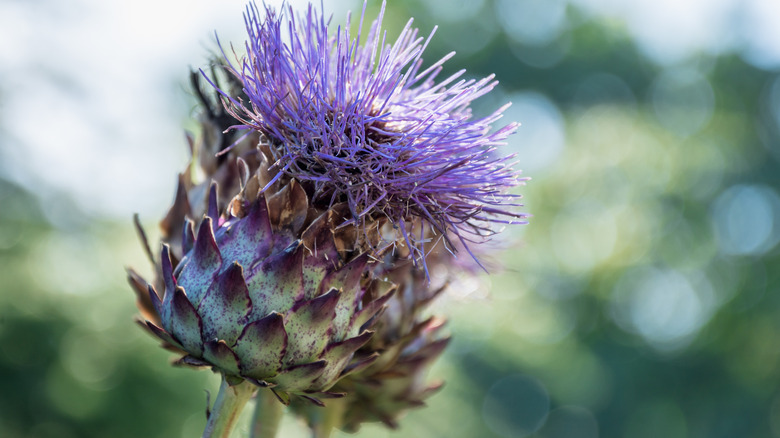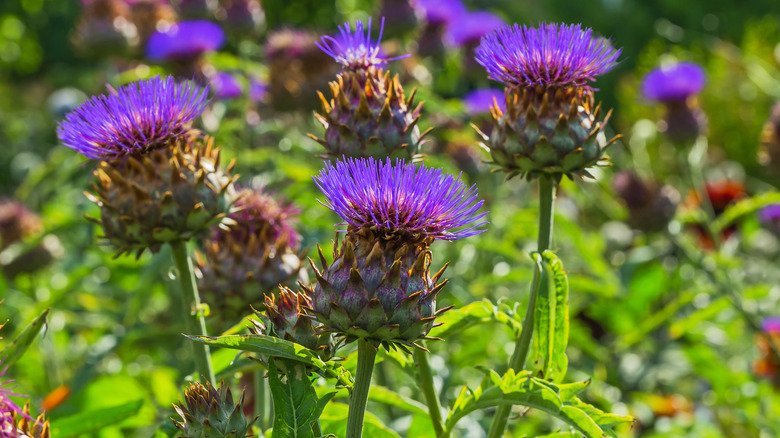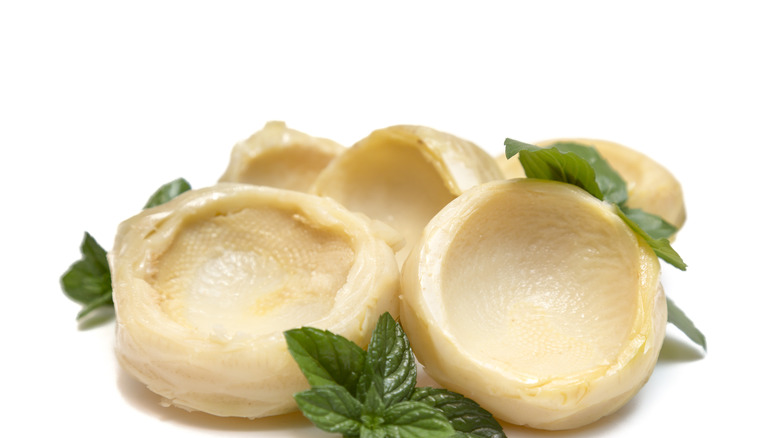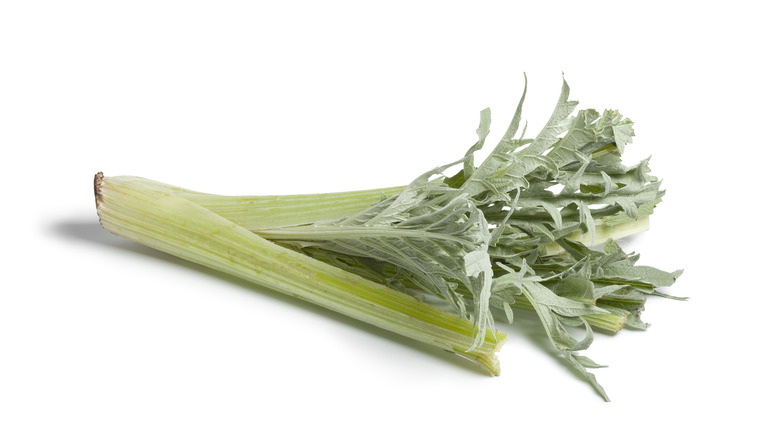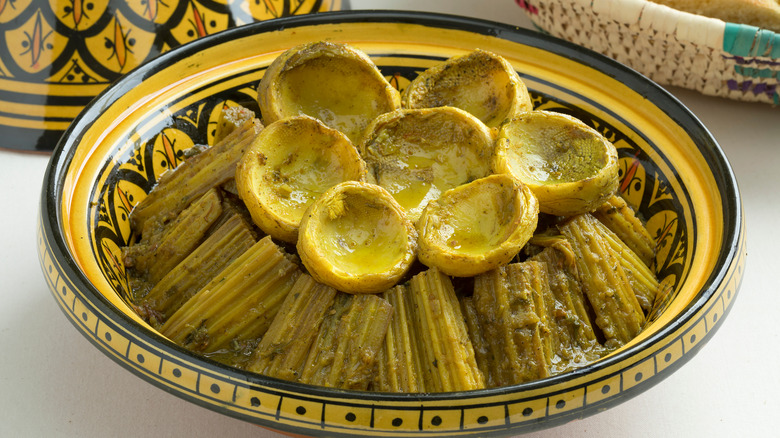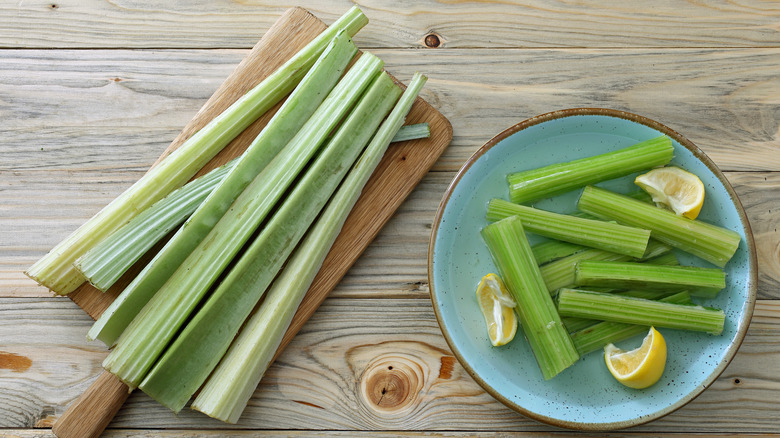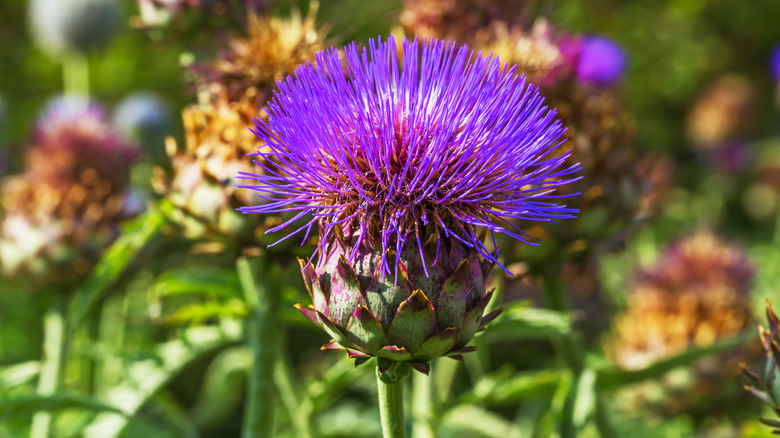What Are Cardoons And What Do They Taste Like?
Cardoons (also known as cardones) are a type of edible thistle native to the Mediterranean region and grown in several parts of the world for decorative and culinary purposes (via Missouri Botanical Garden). A member of the asteracae family alongside dandelion and burdock, the cardoon looks like a cross between a super thick celery and an artichoke, according to Britannica. In fact, the cardoon is such a close relative to the famous green globe that it's sometimes referred to as the artichoke thistle. But make no mistake, this thistle plays second fiddle to no one. In the wild, cardoons grow as high as 6 feet tall and sprout thick grey-green stalks surrounded by fuzzy, jagged leaves and gigantic purple flower buds.
With its eye-catching purple buds, spiny leaves, and robust greyish-green stalks, the cardoon is both a beauty and a beast. That may explain why its scientific name — cynara cardunculus — is derived from the Greek word for dog, "kyon" (via Seedaholic). But don't let that intimidate you. Get to know more about this thistle with us, and you may find yourself wondering why you waited so long to give it a try.
The origins of cardoons
Though you may not have ever heard of cardoons until now, they've been around for quite some time. Per Wisconsin Horticulture, the spiny-leafed thistle was first cultivated by ancient Greeks, Romans, and Persians. They later made their way to other parts of Europe, and then to colonial America — A Taste of History With Joyce White explains they were a fixture in English-language cookbook recipes in the 18th and 19th centuries. But given the amount of work required to prepare them, they lost some of their widespread appeal over time, per Saveur. But cardoons never really went away. Out of style, perhaps. Overshadowed by its artichoke cousin, sure. But cardoons are still very much present, especially in traditional Italian and North African cuisine.
Don't let its obscurity fool you into thinking this vegetable isn't worth the trouble. As Saveur notes, the cardoon features significantly in traditional Italian Christmas meals, Moroccan dishes, and Iranian stews, with many people flocking to specialty markets to get their hands on some. But a yummy, artichoke-like flavor isn't all this thistle has to give. In Portugal and Spain, the enzyme-rich cardoon flower stamens are used as a vegetarian rennet to ripen cheese like the Torta Del Casar and Torta de la Serena (via Culture Cheese Magazine). They're also beloved by florists and gardeners, winning the Royal Horticultural Society's Award of Garden Merit. And, per Plants for a Future, cardoons may even have medicinal properties.
What do cardoons taste like?
Unlike its spiky-leafed relative the artichoke, whose flower buds are stripped petal by petal to get to a tasty heart in the center, cardoons are known for their mild-flavored, edible stalks. Normally, these are braised, steamed, boiled, or fried, but they can also be baked or eaten raw — it's entirely up to personal preference. When the stalks are uncooked, they're said to have a woody flavor and tough, chewy consistency that some find unpalatable, but others believe to be delicious when marinated in olive oil. As Cooks Info points out, many people prefer to parboil the stalks before adding them to other dishes, as this can reduce the bitter flavor.
When cooked, cardoon stalks have a tender texture and mild flavor that make them a pleasant addition to soups, stews, salads, and gratins. Some people compare their taste to the highly-coveted artichoke heart (via The Guardian). This also means they pair well with acidic and rich flavors, like lemon and cheese. The Guardian recommends braising them with herbs, garlic, lemon, and vinegar, plus plenty of rendered fat or olive oil.
Buying and storing cardoons
Since cardoons aren't as popular in the US, they aren't usually available at most major grocery stores. However, you may be able to find fresh cardoons in some seasonal farmers markets or speciality stores. Some Italian groceries may even sell a canned or jarred variety. When buying fresh, look for cardoons that have pale greyish-green colored leaves and heavy, firm stalks. Be mindful of the texture of the leaves — they should be soft to the touch, but neither wilted nor brittle (via Food52).
After you bring your cardoons home, wash them thoroughly and remove the outer skin on the flat side of the stalks as well as the fibrous string, which is inedible. Using gloves might come in handy here, since cardoons are covered in prickles that can irritate the skin.
For best results, The Spruce Eats says to use a vegetable peeler or paring knife to trim the leaves from each stalk, using a downward motion. Plant Abundance on Youtube offers a great video demonstration on how to do this. Next, remove and discard the white string. The more you cut it, the easier the process should become as the strings will start to slide off on their own. As you're cutting, toss each piece of stalk in a bowl of cold water with a splash of lemon or vinegar to prevent discoloration, since the stems will oxidize once exposed to air. Wrap raw cardoon stems in a plastic bag and store in the crisper drawer of your refrigerator for up to a week.
How to cook with cardoons
Though you may think the unusual appearance of cardoons makes them difficult to cook with, they can actually be prepared in many different ways. Tagine, a popular stew from North Africa, often features the stewed stems. Zuppa di Cardi is a brothy Italian dish that derives flavor from cardoons sauteed in butter and oil (via Memorie di Angelina). In Tasting Table's yummy fried cardoons recipe, the stalks are first boiled with white wine, thyme, and lemon, and the fried pieces are garnished with Parmesan and parsley.
Per The Guardian, braising is one of the most popular ways to prepare cardoons because it requires the least amount of prep work. The heat flattens all of the prickly parts while also toning down the bitterness, so there's no need to worry about a ton of prep. Another option is to preserve them in olive oil and serve them alongside an array of dips for a tasty appetizer. Riverford Organic Farmers says cardoons pair well with rich, cheesy flavors, so try a cream cheese-based spread as an accompaniment. You could even use them in place of pasta for a noodle substitute to make a gluten-free lasagna style casserole. To save time, you can boil cardoons up to one day before you actually plan on serving them.
Are cardoons good for you?
Like artichokes, another member of the plant genus Cynara, cardoons are one of the best vegetable sources of vitamin B9, magnesium, and a whole host of other antioxidants and minerals. My Food Data shows that a single one-cup serving of shredded cardoons accounts for 15% of the daily recommended intake for potassium, a vital electrolyte that supports nerve function and helps lower blood pressure. Other research suggests that eating cardoons may be beneficial for the kidneys and liver, since they can reduce blood glucose levels (via National Library of Medicine). They're also low calorie and contain almost no fat, as long as you don't batter and fry them — but we wouldn't blame you if you did, of course.
Still intimidated by cooking this unfamiliar thistle? Adding some chopped cardoon stems to a stew or gratin is an easy way to sneak them into your diet.
Growing your own cardoons
Since cardoons are such a rare find in US grocery stores, it can be a wise decision to add them to your garden. Per The Daily Garden, they're easier to grow than artichokes and considered drought-resistant. This probably explains why they grow like weeds in the Mediterranean and California. Keep cardoon plants outdoors in a sunny area, and you can expect them to be ready for harvest within 120 to 150 days of planting, according to Gardener's HQ. The stalks taste better the younger they are, so they're best removed in spring or winter, right before the plant flowers (via Cooks Info).
If you plan on cooking with homegrown cardoons, Gardener's HQ says their flavor can be improved by a process called blanching (not the cooking term!) which involves building a mound of dirt around the plant and wrapping it in burlap.
Planting cardoons is a great way to add a beautiful pop of color to your garden. Wisconsin Horticulture notes that pollinators like bumblebees and butterflies love the thistle's purple flowers, so having them around can be a boon for other plants you have. Plus, you get the added benefit of access to a unique, nutritious vegetable that's usually quite pricy, so it's a double win. One thing to keep in mind: These thistles like their space! They're nearly twice the size of a standard globe artichoke, so make sure they have plenty of room before you plant them.
